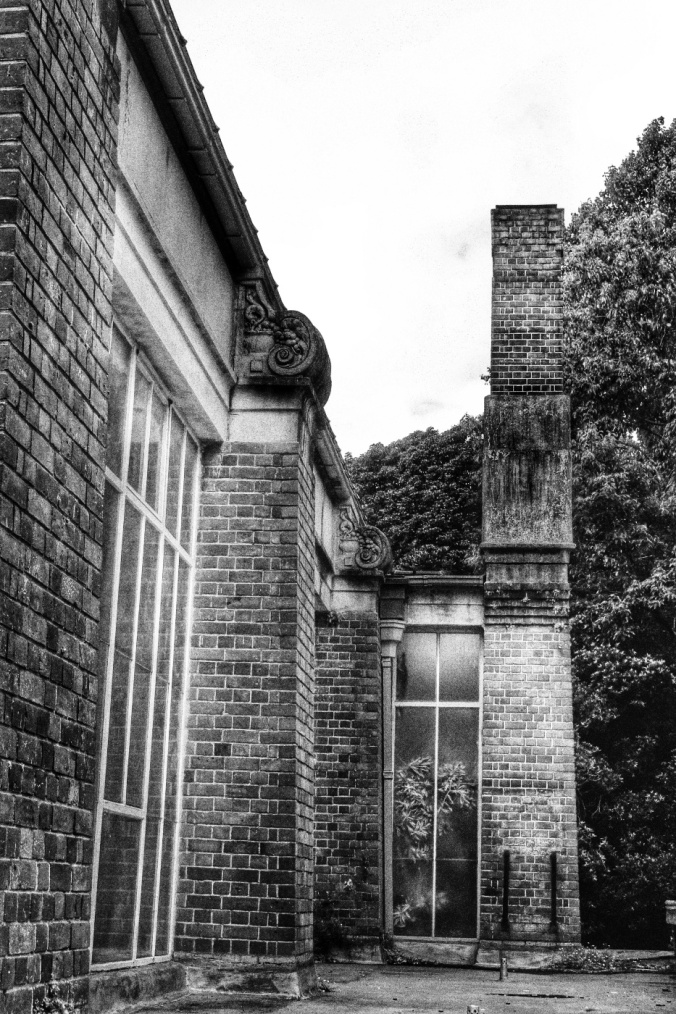
View obscured. Plants in the tropical house at the Auckland Wintergarden, seen from the outside. Image: Su Leslie, 2016. Edited with Snapseed.
I seem to be developing an obsession with the Auckland Wintergardens. More particularly, with the interface between flora and architecture, interior and exterior, exhibition and concealment. A few weeks ago, I found myself pondering the display of exotic plants for human entertainment, or:
the human impulse to capture nature and to use our considerable intelligence and skill to maintain species of life in artificial environments made to simulate their own, in order that we may enjoy those species on our own terms. (Nature Confined)
Yesterday, driven from the pavilions by a busload of very noisy tourists, I found myself thinking about the plants pressed up against the building’s exterior windows. From inside, these are the wallflowers, the backdrop to carefully managed displays. They are the hardest-to-reach and the least likely to be stars of the show.

Anthurium leaves behind glass; tropical house at the Auckland Wintergardens. Image: Su Leslie, 2016. Edited with Snapseed.
The pavilions themselves are showing their age. Built almost 90 years ago, the Wintergardens are like a once-majestic theatre — still putting on a dazzling show for the visitors, but behind the scenes it’s all starting to look a bit faded.

’round the back. Behind the tropical house, Auckland Wintergarden. Image: Su Leslie, 2016. Edited with Snapseed.
I’ve always rather liked the theatrical metaphor for life, drawn from the sociology of Erving Goffman (1922-82). The language of theatre makes sense to me as a way of understanding everyday life (performance, audience, script, props, costumes — even the distinctions between front-of-house and back-stage).
And while we each enact personal performances, we do so within our society, where politics, culture and morality are themselves performed. In this social theatre, some people, groups and ideas are given starring roles. Others are marginalised; relegated to the chorus, to non-speaking parts, or even denied the stage altogether.
As both audience and players, it is our responsibility to understand the staged and constructed nature of social life, and not to forget those squeezed to the fringes — only visible if we really look.
This post was written for Sally D’s mobile photography challenge at Lens and Pens by Sally.
Another interesting metaphor – you’re good at this! Always make me think. And images not too shabby either 😉
LikeLiked by 1 person
Thanks Anabel. I do wonder sometimes how my mind navigates its way though stuff that seems quite innocent and unconnected when I begin!
LikeLiked by 1 person
Su, we definitely have a camaraderie about the intersection of nature and human nature. Your concentration on architecture and nature is an app one–one I savor too. Your images are strongly provoking and tell the tale. Those leaves are a delicious image that is nearing abstraction. Happy Photo Challenge.
LikeLiked by 1 person
Thanks Sally. Yes we do seem to share both an aesthetic and a philosophy of nature. I’m spending more and more time in urban parks these days where the tension between nature and humanity seems very visible.
LikeLike
Pingback: Sally D’s Mobile Photography Challenge: Black and White (Early Spring Awakening) | Lens and Pens by Sally
Interesting affect in black and white.
Leslie
LikeLiked by 1 person
Fascinating post. Su. Very thought-provoking. And it only deepens my desire to visit NZ some day.
LikeLiked by 1 person
Thanks Amy. If you ever do visit, it would be lovely to meet you.
LikeLiked by 1 person
I agree. Now I just need to find enough courage to get on a plane for that long!
LikeLiked by 1 person
🙂 I get that! It is a long flight! Air NZ flies to Houston these days, but it’s a 15-hour flight. I go crazy Auckland-San Francisco, which is about 11 hours.
LikeLiked by 1 person
I’d need serious medications to endure a flight like that. I’m not great on a THREE hour flight to Florida!
LikeLiked by 1 person
😦 After our trip last year, I’ve been trying to figure out ways of avoiding the really long-haul flights. For me, that means Europe via Asia and probably Dubai. Or the US via Tahiti (with a week or so to laze by the pool on Moorea to recover between flights). In my dreams!!!
LikeLiked by 1 person
If only!! If you’re ever on the east coast of the US, let me know.
LikeLiked by 1 person
Will do!
LikeLiked by 1 person
I can see why you find this place interesting. My mind went to a weird place because in B&W and the plants pressing up like that, it’s reminds me of the movies where there’s an asylum and people are pressed up against the glass. Or maybe they would be zombies. 🙂
janet
LikeLiked by 1 person
Hehe. Love the idea of zombie plants! There is definitely an element of a horror movie about the way the plants are pressed against the glass.
LikeLiked by 1 person